|
|
| RHP |
South African
River Health Programme
|
State of the Rivers Report
uMngeni River and Neighbouring Rivers and Streams
|
LOWER UMNGENI RESOURCE UNIT
|
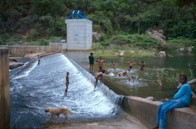
|
From Inanda Dam, the uMngeni River flows from the Thousand Hills with a gentle gradient for 24 km before it flows out to sea just north of Durban. This part of the river is extensively modified, with riparian vegetation and direction of flow significantly altered to accommodate human settlement and activities. Historically the uMngeni River entered Durban bay over a large swampy plain where Durban is now situated. This resource unit is highly urbanized (population 1 314 200). A few smaller rivers are also important here. They include the uMhlatuzana and uMbilo Rivers, which rise in the hills above Durban, draining large areas of urban and industrial development before entering the bay.
|
Water quality in the uMngeni River is Fair, due mainly to the purification of the water in Inanda Dam. Unfortunately by the time the river enters the sea, water quality is Poor from the large volumes of city pollutants.
Riparian health is Fair, but is no longer subject to frequent flooding, resulting in excessive reed growth and invasion by terrestrial weeds.
Instream habitat (Fair) is affected largely by dam-regulated flows and prevention of the natural supply of sand to the river. This causes silting and closing of the estuary, reducing its contact with the marine environment.
Invertebrates are in Good condition although species composition would probably not resemble the natural diversity, due to the unnatural water quality.
|
The river and estuary fish populations are in Fair condition. Water quality of the uMhlatuzana and uMbilo Rivers is Poor, due to urban impacts. Habitat integrity, riparian and instream condition of the uMhlatuzana River are Fair, with resulting invertebrate populations also being in Fair health. The fish are in a Good condition. In the lower reaches the riparian habitat quality deteriorates to Poor.
The uMbilo River habitats are in a Fair condition although mixed, with Good health in the middle reaches and Poor health in the lower reaches. The invertebrates in this river were in a Poor class as a result of the heavy pollution load. Fish are in a poor condition in the lower reaches.
|
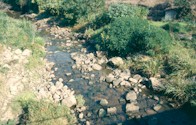
|
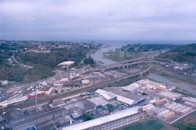
|
Intensive, large-scale urbanization and associated modification of the river course.
Canalisation of the uMngeni, uMbilo and uMhlatuzana Rivers has removed natural habitat in the lower reaches.
High population densities and effluent discharges, excessive nutrients and polluted run-off from streets, factory yards and informal settlements.
Upstream activities, dams and bulk water abstractions alter water quality and sediment dynamics, reduce flow and alter the river's natural flow regime on which many species depend.
Water hyacinth negatively affects the aquatic ecosystem (see p.23).
|
|
Sufficient flow and water volume to transport and assimilate domestic and industrial waste.
The estuary is a nursery area for many marine fishes, and provides for sport angling for kingfish, springer and gurnards. Subsistence fishermen also collect fish from the river here and higher upstream. Blue Lagoon with its beachwood mangroves is an important recreational and educational facility.
Sand mining for construction, although since Inanda Dam was built, the supply of "Umgeni Sand" has diminished.
The flood plain of the river has provided valuable land for building although at a high ecological cost.
The river is extensively used for cultural and spiritual activities.
Recreation: the river below Inanda Dam is used for canoeing.
Much of the Durban Metropolitan Open Space System (which includes education and recreation facilities) is based on these rivers.
|
|
Management of water releases from Inanda Dam to maintain the services provided by the river and estuary.
Management and minimisation of industrial and domestic pollution.
Control of rampant aquatic weed, in particular water hyacinth.
Restoration of riparian vegetation especially by elimination of invasive alien plants (e.g. triffid weed).
Solid waste disposal, especially in the informal areas, is a priority. Litter of the rivers and bay is a widespread aesthetic and health problem.
|
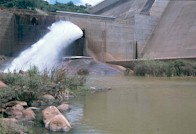
|
|
Estuaries, like rivers, provide us with a wide range of opportunities and benefits. They are an important location for recreational and subsistence activities. The health of estuaries is dependent on the provision of freshwater from the rivers that feed them. By protecting river health, we are also protecting estuaries and the benefits that people derive from them.
The uMngeni estuary is very different today compared to the 1800's. The estuary mouth appears to have moved between the bay and the sea until it was mechanically redirected by the city engineer in the early 1900s due to concerns of flooding, malaria and damage to reclamation works.
There have also been significant changes in the estuary habitat. Between 1934 and 1984 the estuary has lost many of its intertidal and backwater habitats. Also, salt concentrations extended much further inland historically. Bridge construction, industrial and organic pollution and the damming of the rivers appear to exert the most significant impact on the estuary. Altered flows (due to upstream impoundment) have transformed the previously flood-dependent and permanently open estuary to a temporary open/closed system. In the absence of floods, sediment accumulates, changing the ecology of the system and thus the system's ability to provide a certain range of estuary-based goods and services.
Despite human impacts, the uMngeni remains an important estuary. The remaining 44ha of beachwood mangroves in the estuary support a wide diversity of plants and animals. Studies in the early 1980s recorded 56 fish species, 13 prawn species and 11 crab species. The estuary also provides habitat for juvenile marine fish. The uMngeni estuary also provides a variety of recreational opportunities. But, the uMngeni River will need to be managed carefully in order to maintain a desirable level of benefits from the estuary.
|
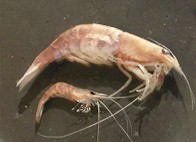
|
The Molweni River, a tributary of the uMngeni at Krantzkloof Nature Reserve near Durban, boasts a freshwater shrimp (Atyoida serrata - large shrimp in photo) only recently found in African waters. It lives exclusively in rocky crevices in torrential water.
|
|